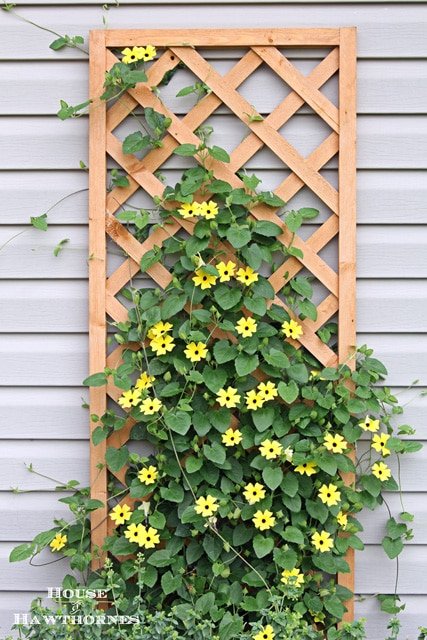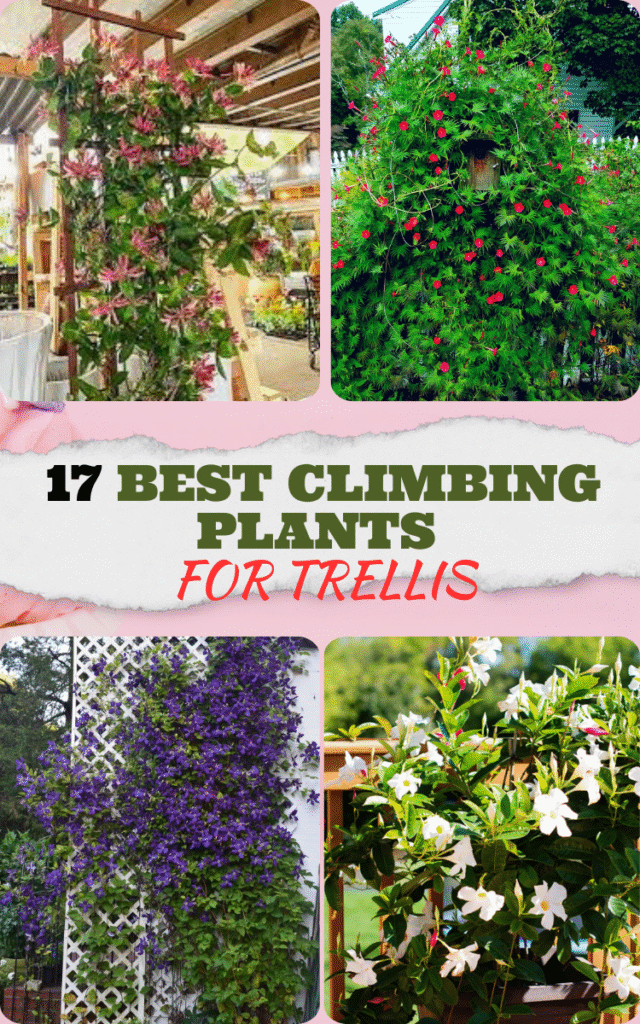
There’s something magical about a garden where plants don’t just stay on the ground but climb, twist, and bloom above eye level. Trellises allow us to add a whole new layer of depth and beauty to our outdoor spaces, turning plain fences or bare walls into living works of art. For me, a simple wooden trellis transformed a forgotten corner of the yard into one of the most admired spots of the garden.
Climbing plants aren’t just about aesthetics; they can serve a practical purpose too. They create shade where you need it, hide unsightly areas, and even give you an edible harvest if you choose wisely. Some climbers grow with wild abandon, quickly covering large spaces, while others take their time and offer steady, manageable growth.
In this guide, I’ll walk you through 17 of the very best climbing plants to grow on a trellis. From show-stopping flowers to lush green covers and even fragrant varieties, there’s a plant here to match nearly every garden style and goal.
Why Use Climbing Plants on a Trellis?
One of the biggest reasons I love trellises is how they maximize space. When you garden vertically, you instantly expand your growing area without needing more ground. This is especially handy in smaller yards, patios, or even balcony gardens where every square foot matters. A trellis covered in greenery makes the space feel more lush without crowding the floor.
Climbers also give you privacy and shade in a natural way. Instead of relying on fences or screens, you can let plants grow into a living wall. This not only looks softer and more welcoming but also attracts birds, butterflies, and pollinators. It’s the type of addition that makes a garden feel alive and constantly changing through the seasons.
And let’s not forget about plant health. Growing upward improves airflow around leaves and flowers, which reduces the chance of fungal diseases that ground-hugging plants sometimes face. It also makes it easier to prune, harvest, or simply enjoy your plants at eye level.
Things to Consider Before Choosing a Climbing Plant
Before you rush to pick out the prettiest climber at the nursery, it’s worth considering your climate and growing zone. Some plants, like bougainvillea, thrive only in warm, sunny regions, while others, such as climbing hydrangea, handle cooler conditions better. Matching the right plant to your environment ensures less frustration and more flourishing growth.
You’ll also want to think about how the plant climbs. Some plants use twining stems, others cling with aerial roots, and some need a little guidance with ties or weaving through the trellis. If your trellis is delicate, avoid vigorous growers like wisteria that can become heavy over time. Lighter vines like sweet peas or morning glories are more forgiving on smaller structures.
Finally, think about the look and purpose you want. Do you want year-round greenery, seasonal flowers, or even fruit? Do you prefer a fragrant plant that perfumes the air or a quick grower that covers space fast? Answering these questions helps narrow down the many choices to the perfect climber for your space.
17 Best Climbing Plants for Trellis
1. Clematis

Clematis is often called the “queen of climbers,” and it’s easy to see why. With countless varieties, it offers an incredible range of colors, flower shapes, and blooming times. From delicate star-shaped blossoms to big, bold flowers, clematis brings a burst of personality wherever it grows.
This plant loves a “cool base, sunny face,” meaning its roots prefer shade while the vines reach up into the sun. I’ve often planted low-growing perennials around the base to keep the soil cool, and it works like a charm. Clematis does require some pruning depending on the variety, but once you get the hang of it, it rewards you with waves of stunning blooms.
On a trellis, clematis looks graceful and refined. It’s a versatile choice, pairing beautifully with roses or other climbers for a layered look. If you want a plant that makes a statement without overwhelming the space, clematis is a wonderful option.
2. Climbing Roses
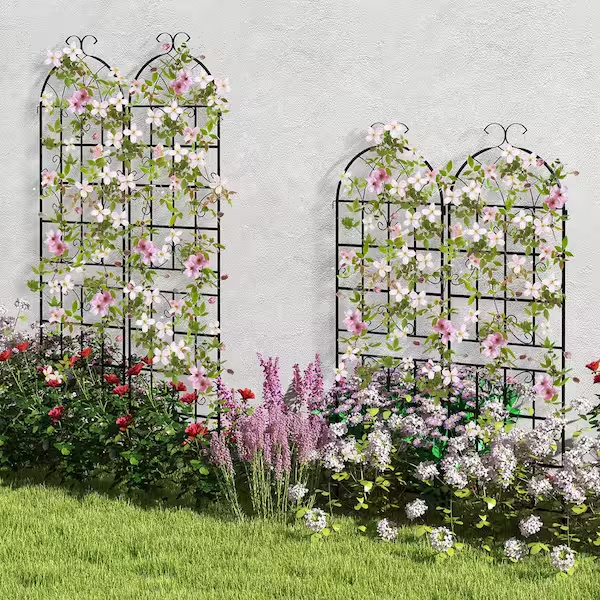
Few things are more romantic in a garden than climbing roses. They bring that classic, storybook feel with their lush blooms and intoxicating scent. On a trellis, they create vertical cascades of flowers that never fail to capture attention.
Climbing roses need a bit of training because they don’t naturally cling on their own. You’ll have to tie or weave them through the trellis to guide their growth. While they require some patience, especially in the early years, the reward is worth it once the trellis is dripping with roses.
These roses also come in a wide range of colors, from soft pastels to deep reds. They can fit into nearly any garden style, whether you’re aiming for cottage charm or a more formal look. Just be prepared for some pruning and a bit of care, and you’ll have a trellis that feels straight out of a painting.
3. Wisteria

If you’ve ever seen a pergola dripping with purple or white wisteria blooms, you know the kind of drama this plant can bring. Its cascading flowers are breathtaking, and their fragrance adds even more to the spectacle. Wisteria on a trellis brings instant wow factor.
However, wisteria is not a plant for the faint of heart. It’s a vigorous grower that can become heavy and unruly if not managed properly. Strong support is essential, as well as regular pruning to keep it under control. Left unchecked, it can overwhelm weaker trellises and nearby plants.
Still, when cared for correctly, wisteria is a showstopper. I’ve found that even a smaller trellis can look enchanting with wisteria trained along it, especially when paired with springtime blooms from other plants. It’s the kind of plant that turns a space into a destination.
4. Honeysuckle

Honeysuckle is one of those plants that draws you in with its fragrance before you even see it. Its sweet, nectar-filled flowers are not only delightful for people but also a magnet for hummingbirds and bees. On a trellis, honeysuckle adds both beauty and a sense of life buzzing around.
This plant is relatively easygoing. It grows quickly, adapts to different soils, and is fairly low-maintenance compared to fussier climbers. Some varieties are evergreen in warmer climates, offering year-round coverage. I’ve enjoyed how honeysuckle can turn a plain corner into a fragrant retreat.
The flowers range in color from creamy yellows to vibrant reds, and they bloom for an extended season. With a honeysuckle-covered trellis, you don’t just get a visual display—you get a sensory experience that changes as the day progresses.
5. Bougainvillea
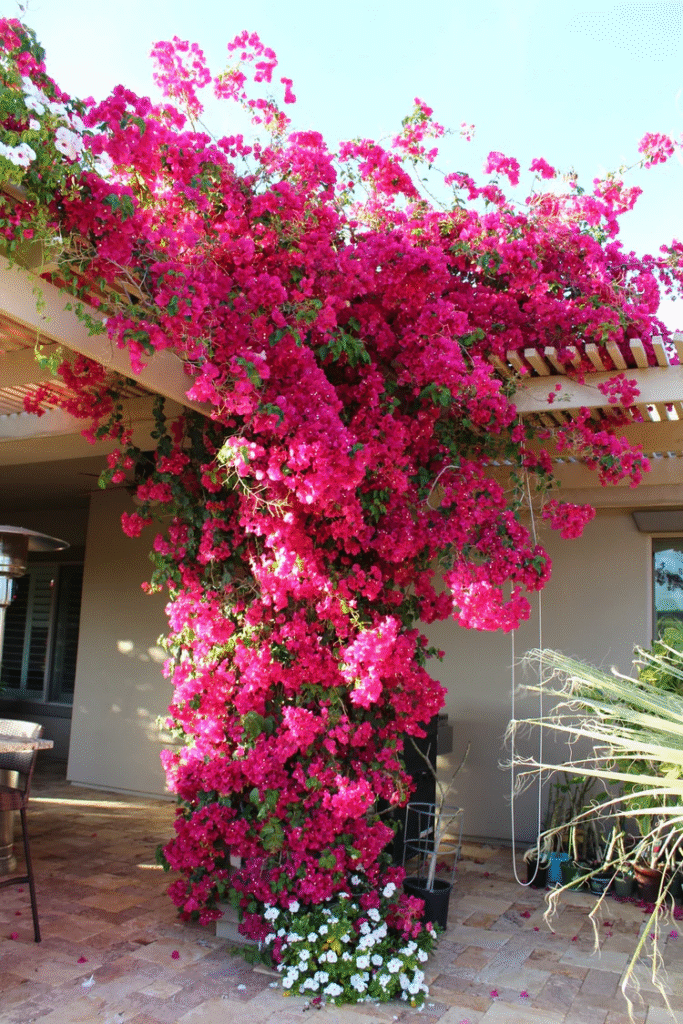
Bougainvillea is a bold choice for a trellis. With its vivid magenta, orange, or purple bracts, it’s one of the most eye-catching climbers out there. In the right climate, this plant grows vigorously, creating a cascade of color that instantly transforms any garden space.
This tropical beauty thrives in sunny, warm regions and doesn’t do well in frost. It loves well-drained soil and a good amount of sunlight. While it may look delicate, bougainvillea is actually quite tough once established, needing little water and care compared to many flowering plants.
On a trellis, bougainvillea creates a vibrant, almost tropical look. I’ve always admired how it brightens up walls and fences, making them look alive. If you’re in a region that can support it, this plant is one of the best ways to make your garden feel like a year-round holiday.
6. Passionflower (Passiflora)
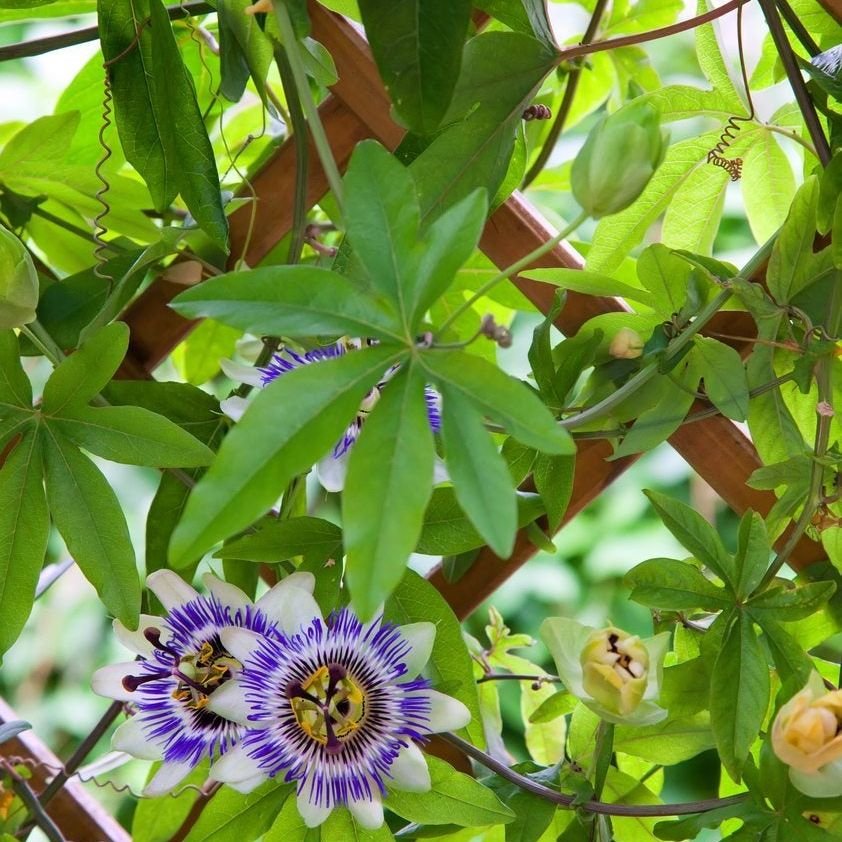
Passionflower is one of the most exotic-looking climbers you can grow. Its intricate, almost alien-like flowers are unlike anything else in the garden. Each bloom is a work of art with layered petals, striking filaments, and bold colors. On a trellis, passionflower feels like a conversation piece as much as a plant.
This climber grows quickly in the right conditions and thrives in sunny spots with well-drained soil. Some varieties even produce edible passionfruit, which is an added bonus. I’ve seen trellises covered in passionflower where the flowers practically stop people in their tracks.
The best part is that passionflower also attracts butterflies and pollinators. If you want to add a tropical, vibrant energy to your garden while also supporting wildlife, this is a climber worth considering.
7. Trumpet Vine (Campsis radicans)
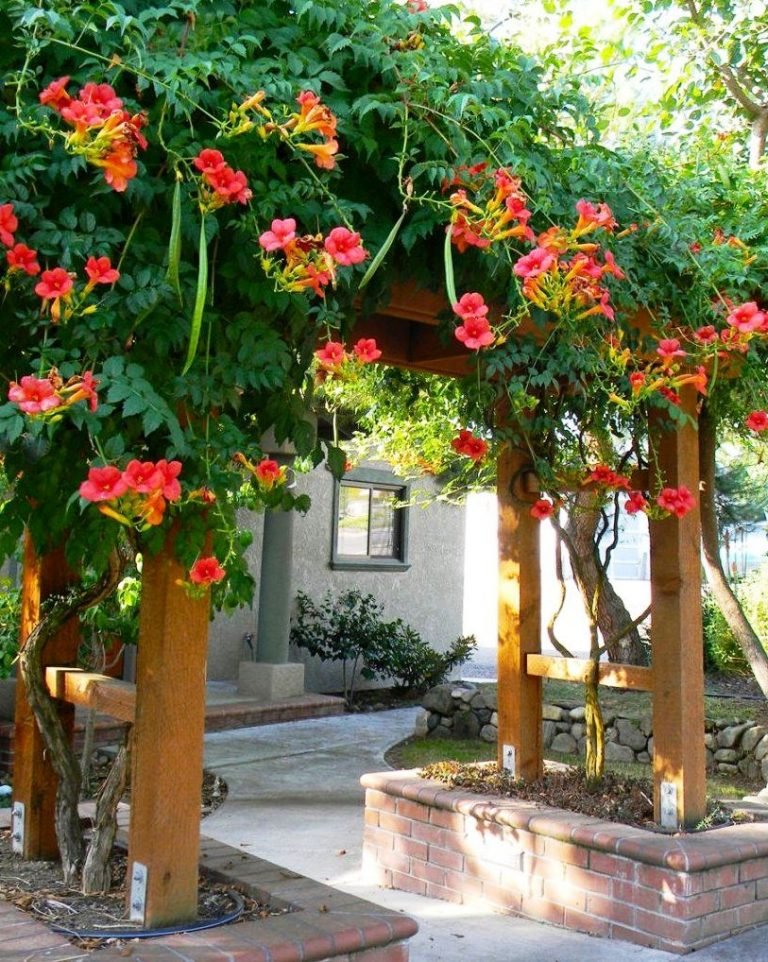
Trumpet vine is one of those plants that brings the drama. With its large, trumpet-shaped flowers in fiery shades of orange and red, it commands attention on any trellis. The blooms are especially loved by hummingbirds, making your garden feel like a living sanctuary.
This vine is vigorous—sometimes too vigorous. It grows fast and strong, and without proper pruning it can take over fences, walls, or even structures not designed to hold its weight. If you’re looking for quick coverage and don’t mind doing some regular maintenance, trumpet vine is ideal.
On a trellis, it makes a bold statement. I once saw a simple wooden trellis completely transformed into a wall of red and orange trumpets—it looked like a burst of summer frozen in bloom. It’s a plant that thrives when given room to sprawl and plenty of sunlight.
8. Morning Glory
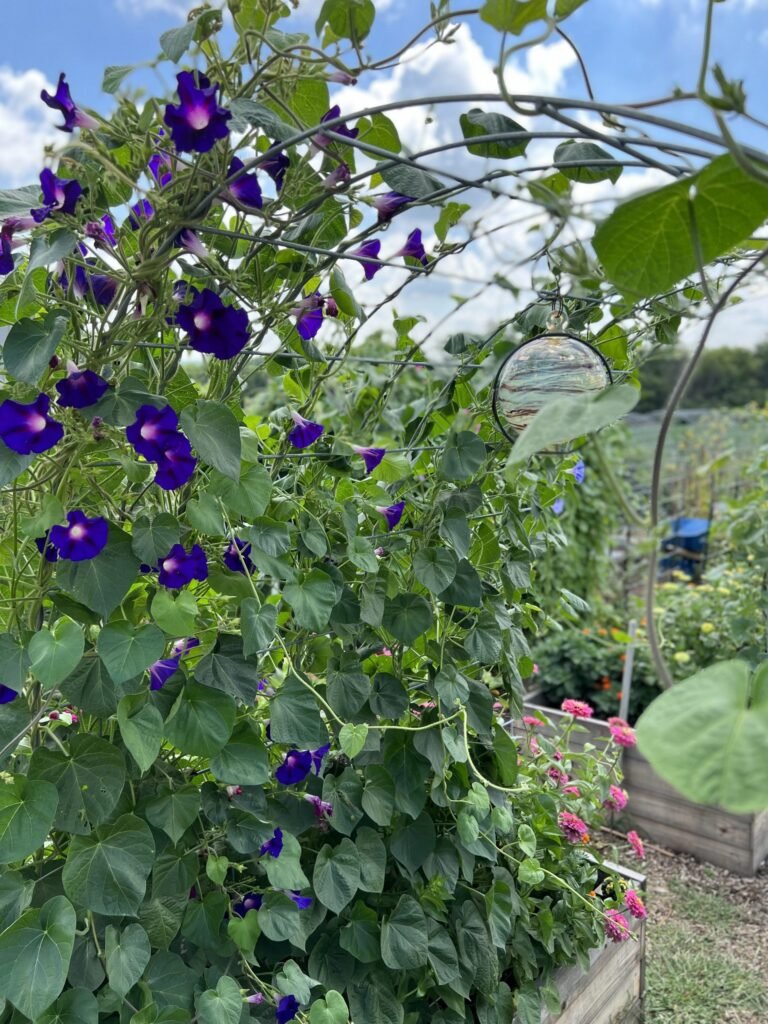
Morning glory is a favorite for gardeners who love fast results. These vines sprout quickly, twine easily, and bloom with cheerful, funnel-shaped flowers that open in the morning and close by afternoon. They’re perfect for softening a trellis with a romantic, slightly wild look.
They come in shades of blue, purple, pink, and white, and their heart-shaped leaves add to the charm. I’ve always loved how morning glories can cover a trellis in just one season, making them an excellent choice if you’re looking for quick impact.
While they’re annuals in many climates, morning glories often reseed themselves and return the following year. On a trellis, they create a lively display that changes daily as the flowers open and close with the sun.
9. Ivy (English Ivy, Boston Ivy)

If you want year-round greenery with minimal fuss, ivy is a reliable choice. It clings easily to trellises, walls, and fences, creating a thick cover of lush green leaves. English ivy in particular has that classic, timeless look, while Boston ivy brings brilliant red and purple foliage in fall.
One of the reasons I appreciate ivy is its low-maintenance nature. It doesn’t demand much attention, and once established, it practically takes care of itself. That said, ivy can become invasive in some regions, so it’s wise to manage it with regular pruning.
On a trellis, ivy creates a backdrop that complements flowering plants or adds structure to shady corners of the garden. It’s not the flashiest climber, but its steady, evergreen presence is hard to beat.
10. Jasmine (Star Jasmine, Confederate Jasmine)

Few plants can rival the fragrance of jasmine. When its star-shaped white flowers open in late spring or summer, the scent fills the air and creates an atmosphere that feels instantly relaxing. A trellis covered in jasmine is both beautiful and aromatic, making it a favorite for patios or seating areas.
Star jasmine is evergreen in many climates, meaning you’ll get year-round green foliage along with the seasonal flush of flowers. It’s a twining plant, so it needs some guidance when growing on a trellis, but once established, it weaves a dense and attractive cover.
I’ve always found jasmine to be one of the best choices when you want a garden that feels as good as it looks. It doesn’t just add vertical interest—it transforms the mood of the space.
11. Sweet Pea
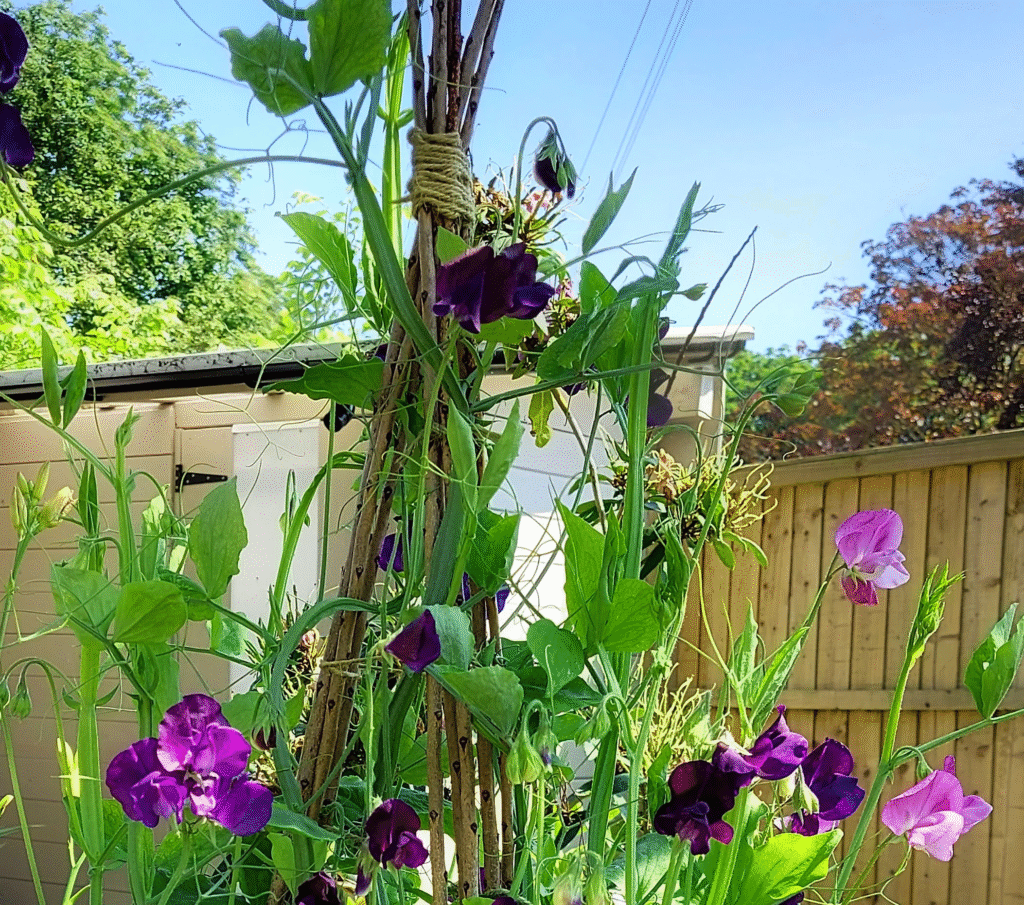
Sweet peas are delicate climbers with an old-fashioned charm. Their flowers, in pastel shades of pink, purple, white, and red, carry a fragrance that’s both soft and sweet. On a trellis, sweet peas bring a whimsical, cottage-garden vibe that never goes out of style.
These are annuals in most regions, so they’re often grown for a single season. But the payoff is worth it: they grow quickly, bloom generously, and add both beauty and scent. I love using them near seating areas where you can catch their fragrance up close.
Sweet peas also make wonderful cut flowers, so your trellis can double as a source of fresh bouquets for the house. With proper care—regular deadheading and watering—you’ll get blooms that last through much of the growing season.
12. Akebia (Chocolate Vine)
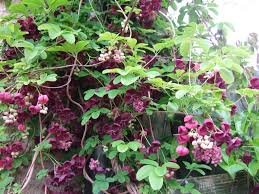
Akebia, often called the chocolate vine, is a lesser-known but highly rewarding climber. Its flowers are small but unique, usually in shades of deep purple or maroon, and they carry a fragrance reminiscent of chocolate. It’s the kind of plant that surprises visitors when they lean in for a closer look.
This semi-evergreen vine grows quickly and prefers full sun to partial shade. It also produces unusual sausage-shaped fruits in the right conditions, which adds another layer of interest. I’ve seen akebia cover a trellis in just a couple of seasons, giving both beauty and lush foliage.
Because it’s a fast grower, you’ll need to prune it regularly to keep it in check. But if you want something a little different that combines fragrance, flowers, and fruit, akebia is an excellent choice.
13. Black-Eyed Susan Vine (Thunbergia alata)
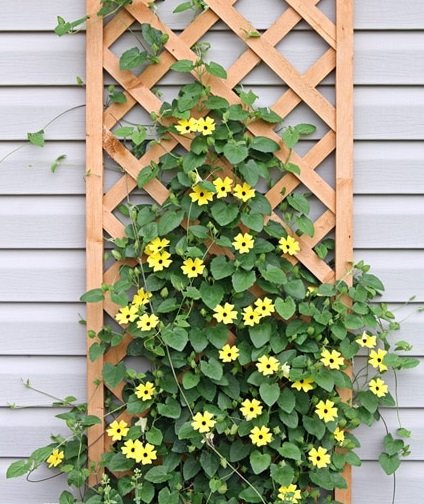
Black-eyed Susan vine is a cheerful, sunny plant that brings instant brightness to a trellis. Its small, daisy-like flowers have vibrant petals in shades of orange, yellow, or white with a striking dark center. The effect is playful and full of energy.
This climber grows quickly in warm weather and is perfect for smaller trellises, obelisks, or even balcony gardens. Unlike more aggressive vines, it’s manageable and easy to grow from seed. I’ve always loved how it gives an instant pop of color without overwhelming the space.
On a trellis, Black-eyed Susan vine creates a tapestry of blooms that seem to smile back at you. It’s an excellent choice for gardeners who want something lighthearted and easygoing.
14. Grapevines
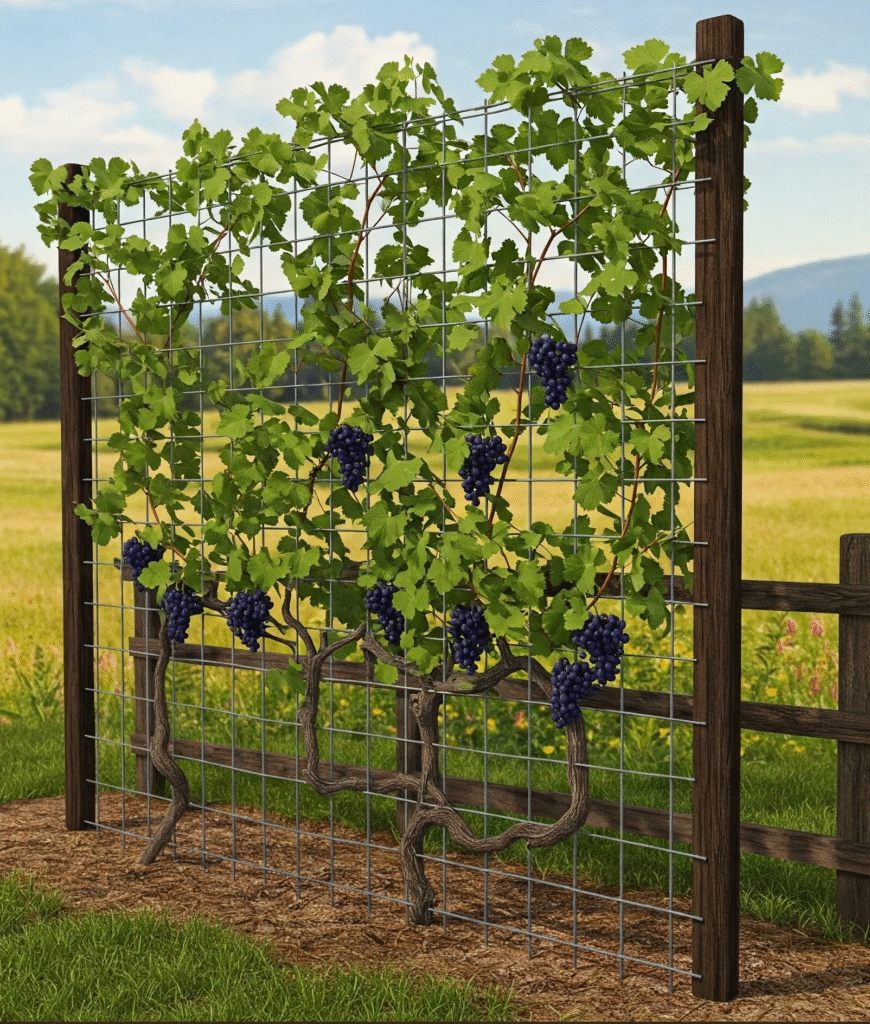
For those who love the idea of beauty and function combined, grapevines are a fantastic option. Their broad leaves provide excellent shade, and their curling tendrils naturally weave through trellis structures. In summer, you also get clusters of grapes that are both ornamental and delicious.
Grapevines need full sun and well-drained soil to thrive. They do require patience and regular pruning to shape them and encourage fruiting. But once established, they’re remarkably hardy and rewarding. I’ve seen trellises transformed into shady nooks where you can sit and enjoy fresh grapes right off the vine.
Beyond the harvest, grapevines have seasonal beauty. In spring, they burst with fresh green growth, in summer they’re lush and full, and in fall their leaves turn golden and red before dropping. A trellis with grapevines offers interest year-round.
15. Hydrangea Petiolaris (Climbing Hydrangea)
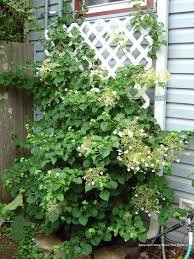
Climbing hydrangea is a standout choice for shady trellises. Unlike many climbers that need full sun, this one thrives in partial to full shade, making it perfect for those trickier corners of the garden. Its large, lace-cap flowers bloom in creamy white clusters, lighting up darker spots beautifully.
It’s a slow grower at first, but once it gets established, it can become quite vigorous. The aerial roots help it cling naturally to trellises, walls, or fences. I’ve seen climbing hydrangea transform an otherwise forgotten shady wall into a lush, flowering feature.
Beyond its flowers, this plant offers year-round interest. Its heart-shaped leaves stay attractive through summer, and in autumn they turn a golden yellow. If you’re patient, this climber will reward you with a trellis that feels elegant and timeless.
16. Cypress Vine

Cypress vine is a delicate, airy climber that adds both texture and charm to a trellis. Its fine, feathery foliage creates a soft, fern-like backdrop, while its bright red or pink star-shaped flowers bring bursts of color. It has a light, graceful look that sets it apart from denser, heavier vines.
This plant is a fast-growing annual that does best in sunny conditions. It’s also a favorite among hummingbirds, which makes it a wonderful addition if you enjoy watching wildlife in the garden. I love how it creates a sense of movement with its slender leaves swaying in the breeze.
On a trellis, cypress vine fills in quickly and provides a more airy coverage compared to other climbers. If you want a plant that feels playful and light while still making an impact, cypress vine is a perfect pick.
17. Mandevilla
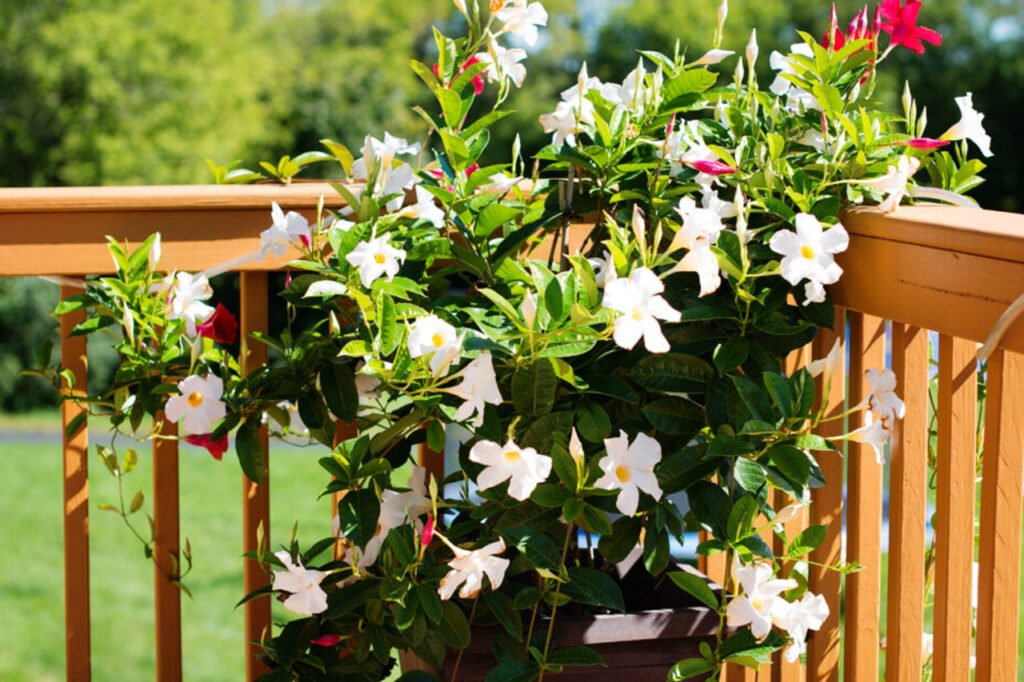
Mandevilla brings a tropical vibe to any trellis with its glossy green leaves and large trumpet-shaped flowers. The blooms, often in shades of pink, red, or white, are bold and vibrant, instantly giving your garden a resort-like feel.
It’s a tender perennial in colder climates but thrives in warm regions. In cooler areas, it can be grown in containers and moved indoors over winter. I’ve always found mandevilla rewarding because it blooms generously throughout the summer and into fall.
On a trellis, mandevilla creates a striking display that pairs well with patios or entryways. If you want a plant that screams summer and adds drama without being overly demanding, mandevilla is one to consider.
Tips for Training and Maintaining Trellis Climbers
Climbers don’t always know where you want them to grow, so a little training goes a long way. Use soft ties, clips, or twine to gently guide stems through the trellis as they grow. Some vines twine naturally, but others, like roses, need a bit of extra help to stay in place. The earlier you start training, the more polished the final result looks.
Pruning is another key part of trellis gardening. Regular trimming not only keeps plants tidy but also encourages more blooms and prevents them from becoming unruly. I’ve found that pruning right after flowering is a safe bet for many climbers, though each plant has its own rhythm.
Don’t forget the basics—water, mulch, and fertilizer. Trellis climbers can dry out faster because they’re elevated and often exposed to wind. A consistent watering routine and some mulch at the base will keep them healthy. Fertilizer, tailored to whether you want more flowers or foliage, can also make a big difference.
Wrapping Up
There’s a certain joy in watching a bare trellis slowly transform into a living wall of greenery and flowers. It’s a process that brings beauty, privacy, and even food or fragrance, depending on the plants you choose. Each climber has its own character—some bold and dramatic, others delicate and subtle—so there’s truly something for every garden style.
The best part is that trellis gardening lets you think vertically, creating depth and dimension without needing more ground space. A well-placed climber can turn the simplest corner into the most captivating part of your outdoor area.
So, take a look at your garden and imagine where a trellis could add that extra touch of charm. Start with one or two climbers that speak to you, and before long, you’ll have a thriving vertical garden that feels alive and full of personality.

